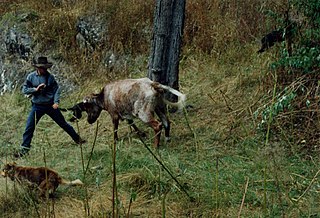Coordinates: 25°55′20″S117°36′00″E / 25.9221°S 117.6001°E Moorarie Station is a pastoral lease currently operating as a sheep station in the Murchison district of Western Australia's Mid West region.

A geographic coordinate system is a coordinate system that enables every location on Earth to be specified by a set of numbers, letters or symbols. The coordinates are often chosen such that one of the numbers represents a vertical position and two or three of the numbers represent a horizontal position; alternatively, a geographic position may be expressed in a combined three-dimensional Cartesian vector. A common choice of coordinates is latitude, longitude and elevation. To specify a location on a plane requires a map projection.
A pastoral lease is an arrangement used in both Australia and New Zealand where Crown land is leased by government generally for the purpose of grazing on rangelands.

A sheep station is a large property in Australia or New Zealand whose main activity is the raising of sheep for their wool and meat. In Australia, sheep stations are usually in the south-east or south-west of the country. In New Zealand the Merinos are usually in the high country of the South Island. These properties may be thousands of square kilometres in size and run low stocking rates to be able to sustainably provide enough feed and water for the stock.
Contents
The property is situated approximately 117 kilometres (73 mi) northwest of Meekatharra and 400 kilometres (249 mi) east of Carnarvon. It is watered by the southern branch of the Murchison River, the Hope River and the Yalgar River. [1]

Meekatharra is a town in the Mid West region of Western Australia. Meekatharra is a Yamatji word meaning 'place of little water'. At the 2016 census, Meekatharra had a population of 708, with 34.0% being of Aboriginal descent.

Carnarvon is a coastal town situated approximately 900 kilometres (560 mi) north of Perth, Western Australia. It lies at the mouth of the Gascoyne River on the Indian Ocean. The popular Shark Bay world heritage area lies to the south of the town and the Ningaloo Reef and the popular tourist town of Exmouth lie to the north. Within Carnarvon is the Mungullah Aboriginal Community. Inland, Carnarvon has strong links with the town of Gascoyne Junction and the Burringurrah Community. At the 2016 census, Carnarvon had a population of 4,426.

The Murchison River is the second longest river in Western Australia. It flows for about 820 km (510 mi) from the southern edge of the Robinson Ranges to the Indian Ocean at Kalbarri. The Murchison-Yalgar-Hope river system is the longest river system in Western Australia. It has a mean annual flow of 208 gigalitres, although in 2006, the peak year on record since 1967, flow was 1,806 gigalitres.




